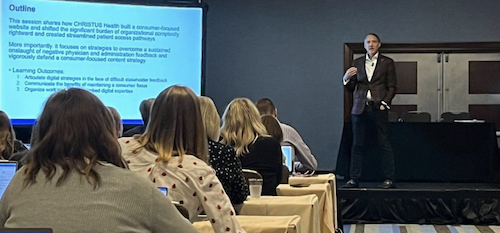
It’s the first full day at SHSMD and two things are standing out so far. First, creating a cohesive, easy-to-use patient experience is a priority for everyone. There are so many sessions about it with phrases in the titles like Personalizing Customer Connections and Rethinking How Health Systems can be more Consumer-Responsive. And second, while everyone would like to be more data-driven and track return on investment (ROI), it is hard to get the data and track ROI.
When it comes to patient engagement, some things are easy. How many people downloaded our app or came to our website? What is the current search volume for non-branded terms like primary care physician near me? What are our HCAHPS scores and star ratings?
Getting to a great mobile app experience or consumer-driven approach to your website may not be that easy, however. Many things can stand in the way, as we learned today. Sometimes the organization’s goals and initiatives are not clear or haven’t been well-conveyed across the organization. In other cases, providers may be hesitant to open their schedules and change the way their profiles are presented to patients. It can take a long time to map the patient's journey and them implement tools that reflect that journey.
We heard about many of these challenges today along with stories about how different organizations have tried to address these issues. However, even when someone takes the lead to help drive important initiatives like improving the digital experience for patients, it may be hard to track to ROI.
In one discussion today, several marketing leaders shared that they would like to be able to dig down into detailed data on how patient engagement and experience initiatives are impacting outcomes or addressing challenges in the call center or front desk. The problem is that often that data is held in multiple places by different departments. Bringing it all together into one dashboard can be a huge challenge.
In the meantime, several people we talked to today said that they still consider anecdotal evidence when it comes to their patient experience. Others said it is enough to see the needle move on patient surveys or online reviews. One person indicated that focusing on individual projects and looking at how to track that one specific measure like reducing unnecessary ED visits was enough.
At one point, a small group of attendees agreed that one of the big issues is that some things take a long time to play out and show measurable change. The question was asked, “can you break those down into smaller goals.” One person said yes sometimes you can and you can keep refocusing people on the ultimate goal and reminding them that Rome wasn’t built in a day. However, people are inpatient and sometimes projects die on the vine before they ever make it to the potential results because they simply take too long.
As we listened to the sessions and discussions it was clear that it will take strong leadership and interdepartmental collaboration to really uncover the true ROI behind patient engagement initiatives. Maybe those will be some of the stories next year at SHSMD. We’ll certainly stay tuned.
The original version of this page was published at: https://www.goziohealth.com/blog/tracking-patient-engagement-why-is-it-so-hard
Gozio Health offers an end-to-end, customizable digital health platform exclusively for healthcare systems. Gozio’s extensible mobile platform enables seamless consumer interactions and provides an... Read more
Earlier this year, The Consumer Technology Association (CTA)® released new research that looks at the state of the U.S. consumer health technology ecosystem and offers recommendations ...read more
After attending many conferences and other events and talking to a lot of Gozio customers, we’ve gotten a pretty good idea of what the priorities and focus will be in 2023. In ...read more
A recent study has confirmed what we’ve known for some time, most people would prefer to manage their healthcare from a single digital platform. The study, Healthcare In ...read more
“The pandemic surely accelerated this move to more targeted digital offerings, but the healthcare industry is absolutely headed to personalized care,” said ORBIE award ...read more